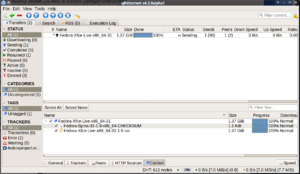Qt
 | |
 qBittorrent v4.3.0alpha1 seeding Fedora Linux's Xfce spin which is available as a torrent at torrents.fedoraproject.org. qBittorrent is written using the Qt toolkit. | |
| Original author(s) |
|
|---|---|
| Developer(s) |
|
| Initial release | May 20, 1995 |
| Written in | C++ |
| Operating system | Android, iOS, Linux (Linux embedded, Wayland, X11), macOS, Microsoft Windows, WebAssembly, and more[1] |
| Platform | Cross-platform |
| Type | Widget toolkit and Application framework |
| License |
|
| Website | www.qt.io |
Qt ("cute") is a cross-platform user interface toolkit available both in both a free GPL edition and a commercially licensed edition. It is used by a lot of free software including the KDE Plasma and the LXQt desktop environments, the Krita painting program, the qBittorrent BitTorrent client, the Avidemux video editor and a whole lot of other applications.
Free software written using Qt tend to be available on Linux, Windows and macOS because of the toolkits cross-platform nature.
License(s)[edit]
The Qt toolkit is free software available under the GNU GPL. The Qt Company, who makes Qt and controls the source code, is also selling Qt as a commercial product under a commercial license. They have signaled that they may start restricting all Qt releases to paying customers for 12 months after new releases are made.
High DPI Scaling[edit]
Qt 4.15+ supports automatic high DPI scaling. This feature can be enabled or disabled with a environment variable called QT_AUTO_SCREEN_SCALE_FACTOR which is set by some of the desktop desktop environments on some of the distributions.
Some applications will behave as if QT_AUTO_SCREEN_SCALE_FACTOR=1 while others will behave as if it is set to QT_AUTO_SCREEN_SCALE_FACTOR=0 if that variable has not been set.
Random Qt and KDE applications blowing up and becoming too gigantic, or being too small depending on your preferences, can be solved by setting QT_AUTO_SCREEN_SCALE_FACTOR to either 0 or 1.
Qt tries to get the scale factor either set or detected by the system it is running on (see HOWTO set DPI in Xorg).
QT_SCALE_FACTOR can be used as an alternative to QT_AUTO_SCREEN_SCALE_FACTOR. Do note that automatic scaling will override the QT_SCALE_FACTOR variable if QT_AUTO_SCREEN_SCALE_FACTOR=1.
You can use QT_SCALE_FACTOR to do per-application scaling (if some should be bigger than others) only if you stick with QT_AUTO_SCREEN_SCALE_FACTOR=0.
QT_SCALE_FACTOR can be set to any numeric value such as 1.1, 1.3.
Qt 5 scaling is documented on doc.qt.io/qt-5/highdpi.html.
Links[edit]
The Qt website is at qt.io.
Complaints should be filed at bugreports.qt.io. The code-review status tracker is at codereview.qt-project.org /q/status:open.

Enable comment auto-refresher